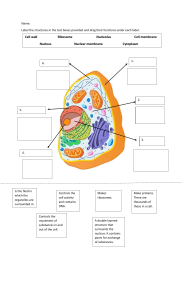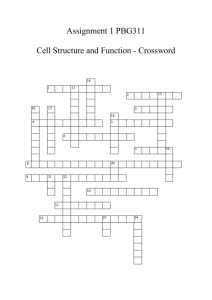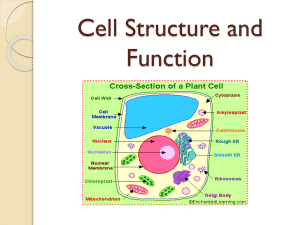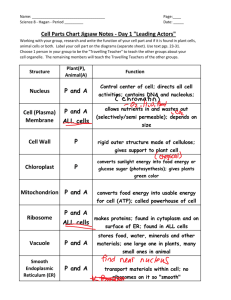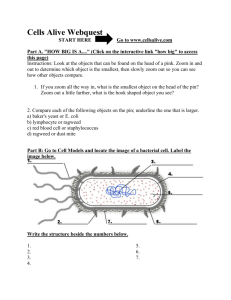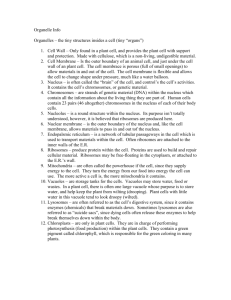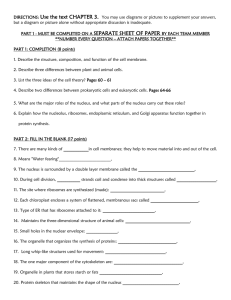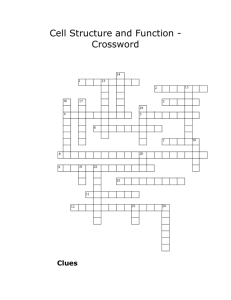CELL-WEBQUEST-2015-16-TASK-2-FLASH-CARD
advertisement
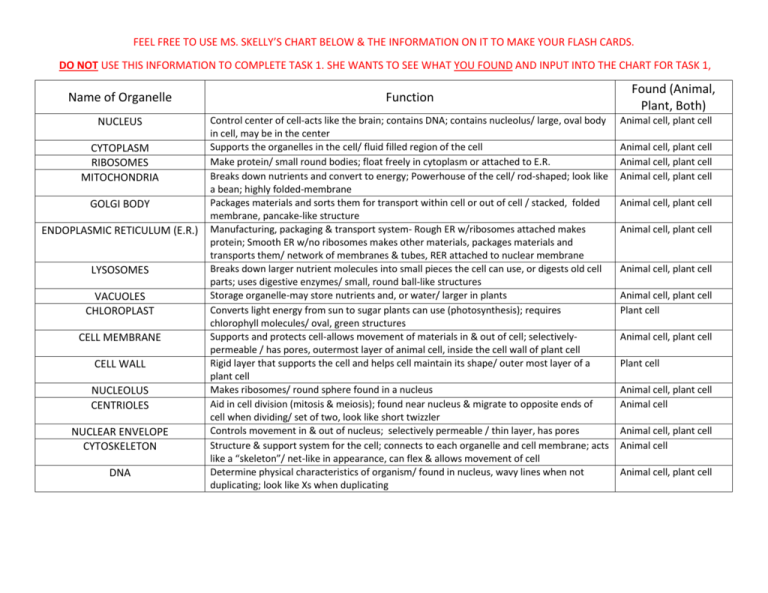
FEEL FREE TO USE MS. SKELLY’S CHART BELOW & THE INFORMATION ON IT TO MAKE YOUR FLASH CARDS. DO NOT USE THIS INFORMATION TO COMPLETE TASK 1. SHE WANTS TO SEE WHAT YOU FOUND AND INPUT INTO THE CHART FOR TASK 1, Name of Organelle Function NUCLEUS Control center of cell-acts like the brain; contains DNA; contains nucleolus/ large, oval body in cell, may be in the center Supports the organelles in the cell/ fluid filled region of the cell Make protein/ small round bodies; float freely in cytoplasm or attached to E.R. Breaks down nutrients and convert to energy; Powerhouse of the cell/ rod-shaped; look like a bean; highly folded-membrane Packages materials and sorts them for transport within cell or out of cell / stacked, folded membrane, pancake-like structure Manufacturing, packaging & transport system- Rough ER w/ribosomes attached makes protein; Smooth ER w/no ribosomes makes other materials, packages materials and transports them/ network of membranes & tubes, RER attached to nuclear membrane Breaks down larger nutrient molecules into small pieces the cell can use, or digests old cell parts; uses digestive enzymes/ small, round ball-like structures Storage organelle-may store nutrients and, or water/ larger in plants Converts light energy from sun to sugar plants can use (photosynthesis); requires chlorophyll molecules/ oval, green structures Supports and protects cell-allows movement of materials in & out of cell; selectivelypermeable / has pores, outermost layer of animal cell, inside the cell wall of plant cell Rigid layer that supports the cell and helps cell maintain its shape/ outer most layer of a plant cell Makes ribosomes/ round sphere found in a nucleus Aid in cell division (mitosis & meiosis); found near nucleus & migrate to opposite ends of cell when dividing/ set of two, look like short twizzler Controls movement in & out of nucleus; selectively permeable / thin layer, has pores Structure & support system for the cell; connects to each organelle and cell membrane; acts like a “skeleton”/ net-like in appearance, can flex & allows movement of cell Determine physical characteristics of organism/ found in nucleus, wavy lines when not duplicating; look like Xs when duplicating CYTOPLASM RIBOSOMES MITOCHONDRIA GOLGI BODY ENDOPLASMIC RETICULUM (E.R.) LYSOSOMES VACUOLES CHLOROPLAST CELL MEMBRANE CELL WALL NUCLEOLUS CENTRIOLES NUCLEAR ENVELOPE CYTOSKELETON DNA Found (Animal, Plant, Both) Animal cell, plant cell Animal cell, plant cell Animal cell, plant cell Animal cell, plant cell Animal cell, plant cell Animal cell, plant cell Animal cell, plant cell Animal cell, plant cell Plant cell Animal cell, plant cell Plant cell Animal cell, plant cell Animal cell Animal cell, plant cell Animal cell Animal cell, plant cell
